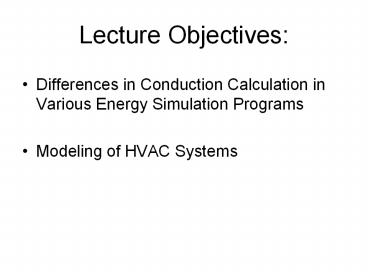Lecture Objectives: - PowerPoint PPT Presentation
1 / 22
Title:
Lecture Objectives:
Description:
Lecture Objectives: Differences in Conduction Calculation in Various Energy Simulation Programs Modeling of HVAC Systems Methods for conduction calculation Finite ... – PowerPoint PPT presentation
Number of Views:108
Avg rating:3.0/5.0
Title: Lecture Objectives:
1
Lecture Objectives
- Differences in Conduction Calculation in Various
Energy Simulation Programs - Modeling of HVAC Systems
2
Methods for conduction calculation
- Finite difference or finite volume method
- Weighting factor method
- Response factor method
- or Response function method
3
Methods for conduction calculation
- Finite difference or finite volume methods
- Used in your HW assignments
- Energy simulation program
- ESPr
- Some models in TRANSYS
- Some models in EnergyPlus
4
Conduction with finite difference (volume) method
Example room
5
System with the finite difference (volume) method
for conduction calculation
6
Weighting factor methods
The simplest method
T external air T internal air Q
solar Orientation and Wall (or element)
structure
Heat flux on internal surface
database
q
7
System when we know the fluxes thought building
walls
We need to find other way to calculate fluxes
8
Response function methods
- Used in eQUEST program
9
Response function methods
NOTATION ?(x,t)T(x,?)
10
Laplace transformation
Laplace transform is given by
Where p is a complex number whose real part is
positive and large enough to cause the integral
to converge.
11
Laplace transformation table
12
Principles of Response function methods
The basic strategy is to predetermine the
response of a system to some unit excitation
relating to the boundary conditions anticipated
in reality. Reference JA Clarke Book form the
Reference List
13
Modeling of HVAC systems
- Review
- Psychrometrics
- Air-conditioning in Air Handling Units (AHU)
- Refrigeration cycles
- Building-System-Plant connection
14
Psychrometrics review
15
Air-conditioning in Air Handling Unit (AHU)
AHU
AHU schematic
Exhaust
From room
Return fan
flow control dampers
Supply fan
Compressorand Condenser
Fresh air
To room
Outdoor air
hotwater
coolwater
16
Processes in AHU presented in Psychrometric in
psychrometric
Case for Summer in Austin
OA
MA
IA
SA
17
Refrigeration Cycle
Released energy (condenser)
T outdoor air
T cooled water
- What is COP? - How the outdoor air temperature
affects chiller performance?
Cooling energy (evaporator)
18
Building-System-Plant
HVAC System (AHU and distribution
systems)
Plant (boiler and/or Chiller)
Building
19
Integration of HVAC and building physics models
Load System Plant model
Building
Heating/Cooling System
Plant
Qbuiolding
Q including Ventilation
and Dehumidification
Integrated models
20
HW3System simulation
- Simplified model (use ii in your HW3a)
- Use the results from HW2 and calculate the
sensible cooling requirement for 24 hours for ten
identical rooms like the one from HW2b. - If infiltration/ventilation provides 1 ACH
calculate the latent load from infiltration 24
hours for ten identical rooms like the one from
HW2b. - Calculate the total cooling load for 24 hours for
ten identical rooms like the one from HW2b. - Use this as Q cooling (?) for HW3b
- Note This method
- - assumes perfect process in AHU
- to control RH sometimes we need to heat and
cool at the same time - - neglects fan power
- - dos not consider system properties and control
- Variable Air Volume or Constant Air Volume
21
Plant ModelsChiller
P electric (?) COP (?) x Q cooling coil (?)
TOA
What is COP for this air cooled chiller ?
T Condensation TOA ?T
Evaporation at 1oC
TCWS5oC
TCWR11oC
water
Building users (cooling coil in AHU)
COP is changing with the change of TOA
22
HW3Chiller model COP f(TOA , Qcooling ,
chiller properties)
Chiller data QNOMINAL nominal cooling
power, PNOMINAL electric consumption for
QNOMINAL
The consumed electric power KW under any
condition
Available capacity as function of evaporator and
condenser temperature
Cooling water supply
Outdoor air
Full load efficiency as function of condenser and
evaporator temperature
Efficiency as function of percentage of load
Percentage of load
The coefficient of performance under any
condition































